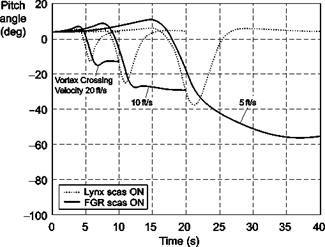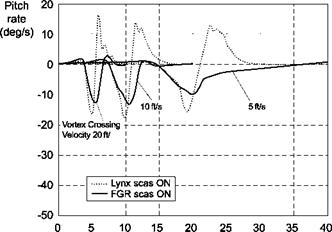Analysis of encounters – attitude response
Figures 8.54-8.57 show aspects of the helicopter attitude response to a vortex encounter with no pilot recovery inputs. Figures 8.54 and 8.55 show the pitch attitude and rate response of the rotorcraft for three vortex encounter speeds: 5, 10 and 20 ft/s (~1.5, 3 and 6 m/s). The attitude transients increase as vortex-passing speed decreases as expected, since the aircraft is exposed to the vortex flow-field for longer. Note that the attitude hold system in the Lynx SCAS returns the aircraft to the hover attitude after the passage of the vortex, contrasting with the rate-damping SCAS in the FGR, which leaves the aircraft in a disturbed attitude state. Both rotorcraft initially pitch up as they pass through the advancing tail of the vortex induced by the lateral distribution of inflow through the rotor disc. As the rotor hub encounters the vortex core, the lateral inflow distribution reverses, leading to a much larger flapping and nose-down pitching moment. The attitude perturbations for the 10 and 20 ft/s encounters are approximately 30 and 20°, respectively, in 3-4 s, similar for both aircraft, while the slower encounter results in a pitch of nearly 40° in 5 s for the Lynx and more than 50° in 10 s for the FGR.
The pitching moment and corresponding accelerations are much higher on the Lynx with its hingeless rotor system, but the FGR is pitched to the larger attitude
|
Fig. 8.54 Pitch attitude response |
|
Time (s) Fig. 8.55 Pitch rate response |
because the increased diameter rotor is in the vortex for about 30% longer. The pitch response would be reversed for clockwise rotors (e. g., Eurocopter Super Puma).
The attitude responses are plotted on the pitch quickness charts in Figs 8.55 and 8.56. On each chart the maximum quickness is also plotted as a function of attitude derived from applying high-amplitude pulse inputs with varying duration. The ADS-33 handling qualities boundaries are also included.
Both aircraft have significant quickness margin (40-100%) to overcome the vortex, up to the 30° pitch attitude change (limit set in the ADS manoeuvre performance). Also, just meeting the ADS-33 minimum quickness requirements for tracking tasks (Level 1/2 boundary) gives a significant response margin (50-100%) for attitude changes up to 30°. It should be recognized that the pitch rates are transient and the nature of encounters is such that the pilot should need to apply compensatory control inputs only momentarily. This is not to say that the transient disturbance is not a serious handling ‘problem’ for the pilot. Such encounters are most likely to occur close to airports, and Ref. 8.56 highlights the result that pilots would most likely abort an approach following such upsets. The results also indicate that an aircraft that just met the minimum Level 1/2 quickness requirements for general MTEs would have wholly inadequate control for counteracting the effects of a vortex encounter. As with control system failures, quantifying response in terms of flight-handling qualities parameters provides a description of severity that links with safety and provides the basis for safety cases. While the attitude response is important, the vertical disturbance can be even more serious.













